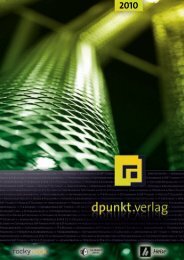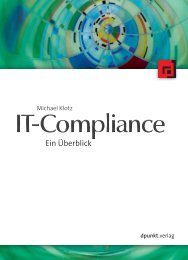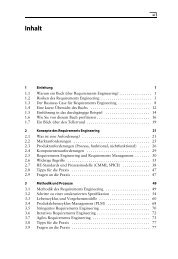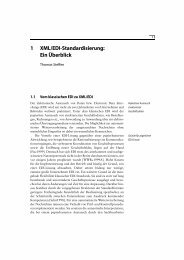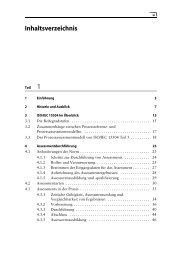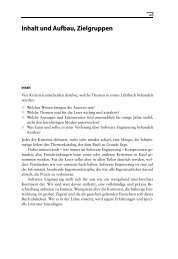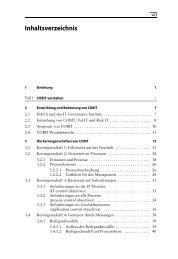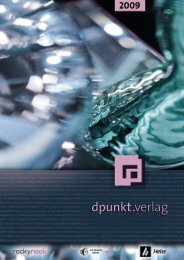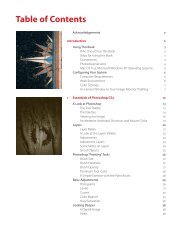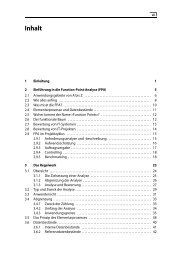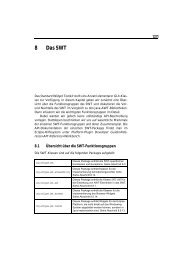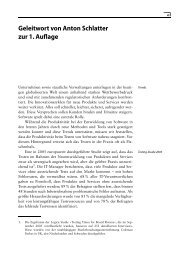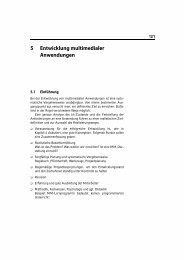Model Driven Architecture
Model Driven Architecture
Model Driven Architecture
You also want an ePaper? Increase the reach of your titles
YUMPU automatically turns print PDFs into web optimized ePapers that Google loves.
<strong>Model</strong> <strong>Driven</strong> <strong>Architecture</strong>
Dr. Roland Petrasch ist freier IT-Berater und Professor für Informatik<br />
(Lehrgebiet Software-Engineering) an der TFH Berlin. Seine<br />
Lehr- und Forschungsschwerpunkte sind u.a. Vorgehensmodelle,<br />
IT-Projekt- und Qualitätsmanagement, <strong>Model</strong>le und Methoden<br />
des Software-Engineerings sowie Requirements- und Usability-<br />
Engineering. Seit über 20 Jahren beschäftigt er sich mit der Software-Entwicklung<br />
und arbeitete in der Industrie als Software-<br />
Entwickler, Berater und Projektleiter.<br />
Dipl.-Inf. (FH) Oliver Meimberg studierte Informatik an der TFH<br />
Berlin. Seit ca. zehn Jahren beschäftigt er sich mit Methoden des<br />
Software-Engineerings, insbesondere mit der generativen Programmierung<br />
und der modellgetriebenen Software-Entwicklung.<br />
Er ist Geschäftsführer des Software-Unternehmens form4<br />
GmbH & Co. KG.<br />
Dipl-Inf. (FH) Karsten Thoms beschäftigt sich schwerpunktmäßig mit modellgetriebenen<br />
Entwicklungsverfahren, der J2EE-Plattform und mit bekannten Java Open-Source Frameworks.<br />
Er ist aktiv an der Entwicklung des open<strong>Architecture</strong>Ware-Projekts beteiligt. Als<br />
Senior-Consultant bei der itemis GmbH & Co. KG begleitet er Kundenprojekte über alle Projektphasen.<br />
Zurzeit ist Herr Thoms an der Entwicklung eines Produktes bei T-Systems beteiligt,<br />
wo er u.a. die modellgetriebene Entwicklung unter Verwendung von open<strong>Architecture</strong>-<br />
Ware einführt.<br />
Dipl.-Inf. (FH) M.Sc. Florian Fieber studierte Informatik und Information Systems an der<br />
TFH Berlin und der Pforzheim Graduate School. Er hat mehrjährige Berufserfahrung als Software-Entwickler<br />
und war u.a. bei IBM in Deutschland und dem Software-Unternehmen<br />
Openly Informatics Inc. in den USA tätig. Zur Zeit arbeitet Herr Fieber als Forschungsassistent<br />
an der TFH Berlin und beschäftigt sich dabei mit modellbasierter Software-Entwicklung<br />
sowie dem Projekt- und Qualitätsmanagement.
Roland Petrasch · Oliver Meimberg<br />
<strong>Model</strong> <strong>Driven</strong><br />
<strong>Architecture</strong><br />
Eine praxisorientierte Einführung in die MDA<br />
Mit Gastbeiträgen von Florian Fieber und Karsten Thoms
Roland Petrasch<br />
petrasch@SoftwareQuality.de<br />
Oliver Meimberg<br />
oliver.meimberg@form4.de<br />
Lektorat: René Schönfeldt<br />
Copy-Editing: Sandra Gottmann, Münster<br />
Satz & Herstellung: Birgit Bäuerlein<br />
Umschlaggestaltung: Helmut Kraus, www.exclam.de<br />
Druck und Bindung: Koninklijke Wöhrmann B.V., Zutphen, Niederlande<br />
Bibliografische Information Der Deutschen Bibliothek<br />
Die Deutsche Bibliothek verzeichnet diese Publikation in der Deutschen Nationalbibliografie;<br />
detaillierte bibliografische Daten sind im Internet über abrufbar.<br />
ISBN 3-89864-343-3<br />
1. Auflage 2006<br />
Copyright © 2006 dpunkt.verlag GmbH<br />
Ringstraße 19<br />
69115 Heidelberg<br />
Die vorliegende Publikation ist urheberrechtlich geschützt. Alle Rechte vorbehalten. Die Verwendung<br />
der Texte und Abbildungen, auch auszugsweise, ist ohne die schriftliche Zustimmung des Verlags<br />
urheberrechtswidrig und daher strafbar. Dies gilt insbesondere für die Vervielfältigung, Übersetzung<br />
oder die Verwendung in elektronischen Systemen.<br />
Es wird darauf hingewiesen, dass die im Buch verwendeten Soft- und Hardware-Bezeichnungen sowie<br />
Markennamen und Produktbezeichnungen der jeweiligen Firmen im Allgemeinen warenzeichen-,<br />
marken- oder patentrechtlichem Schutz unterliegen. Insbesondere sind <strong>Model</strong> <strong>Driven</strong> <strong>Architecture</strong>,<br />
MDA, Object Management Group, Unified <strong>Model</strong>ing Language, UML, MOF, XMI Warenzeichen oder<br />
eingetragene Warenzeichen der Object Management Group (OMG), Inc., USA<br />
Alle Angaben und Programme in diesem Buch wurden mit größter Sorgfalt kontrolliert. Weder Autor<br />
noch Verlag können jedoch für Schäden haftbar gemacht werden, die in Zusammenhang mit der<br />
Verwendung dieses Buches stehen.<br />
5 4 3 2 1 0
Geleitwort<br />
The world is full of ancient and immense tributes to the builder’s art.<br />
Notre Dame Cathedral in Paris inspires to worship God, as it was<br />
intended to do – imagine being a 15 th century peasant and coming<br />
upon such magnificence! Angkor Wat, once freed from the jungle that<br />
overran it, brings the same sense of awe (and in fact, for the same general<br />
purpose). Eighth century monuments in the first capital of united<br />
Japan, in Nara, tower over the visitor, reminding him of the significance<br />
of that unification and the power of the warlords and their<br />
newly-imported Buddhist ideas. Entire cities of pyramids to the Gods,<br />
to the stars, to the seasons fill plains near México City in Teotihuacán,<br />
and on the sands near the Nile Delta of Egypt.<br />
That these ancient monuments still stand, some after literally<br />
thousands of years, appears to speak to deep knowledge about the<br />
construction of permanence. Especially visitors from a young country<br />
(such as my own) often wonder at the abilities of technologically poor<br />
builders and societies to create such gravity-defying feats. How in the<br />
world did 15 th Century European builders know how to build the<br />
Catedrál de México to stand five hundred years against gravity, and<br />
not collapse? Even more amazing, ancient Egyptian temples have<br />
stood millennia – how did they do it?<br />
Just one last example: the enormous Church on the Spilled Blood,<br />
along the Griboedova Canal in St. Petersburg. Tall and imposing, with<br />
nearly every surface inside & out covered with magnificent mosaic tile<br />
work, surviving even the 75-year experiment with Communism that<br />
found it used primarily as a warehouse. How did its builders know<br />
how to build such permanence?<br />
In fact, this final example is different than all the others: the<br />
Church on the Spilled Blood, in historical terms, was built only yesterday.<br />
A late 19 th Century construction, it was designed. Architects<br />
made plans, plans which were used not only to sell an overall design to<br />
v
vi<br />
Geleitwort<br />
the buyer (in fact, the Tsar of all the Russias), but also plans which<br />
were used by engineers to estimate stresses and strains; used by builders<br />
to calculate construction methodology and choose materials; used<br />
by procurers to choose & purchase those building materials and deliver<br />
them to the now-hallowed site.<br />
In contrast to the Russian example, the ancient Egyptians and<br />
Mayans (and even the Medieval builders of Europe) were comparatively<br />
more impressive: they did not have all the engineering knowledge<br />
they needed to build their monuments. So how is it that these<br />
more ancient monuments survive? It makes the question even more<br />
pressing. The answer, of course, is that they were lucky. It has been<br />
estimated that some 90% of all Medieval cathedral construction failed<br />
and is no longer with us; I would be surprised if the odds were any better<br />
for the ancients. Even those still standing have featured partial collapses,<br />
repaired over the years; the Giralda Cathedral in Sevilla sports<br />
a dome much newer than most of its structure. The same is true across<br />
Europe, and all of the world.<br />
By contrast, when one of the last governments of the Soviet Union<br />
decided to restore the masterful Church on the Spilled Blood, they had<br />
a running start: they had the plans, they had the blueprints. They did<br />
not have to reverse-engineer the structure to repair it to its former (and<br />
now current) beauty. There were even photographs, albeit monochrome,<br />
which helped in reconstruction. The same can be said of the<br />
magnificent Frauenkirche of Dresden; for half a century after World<br />
War II it remained a pile of rubble, yet now the lovely cathedral lives<br />
again, thanks to plans, blueprints and meticulous craftsmanship.<br />
This is, in fact, what we call engineering: a craft which builds on<br />
knowledge, and plans that construction. And by that measure, it is<br />
unfair and unreasonable to call most software development in 2006<br />
»engineering,« since plans rarely feature in software construction.<br />
This I daresay contributes to the absolutely abysmal odds of success in<br />
large and complex software development projects – by some estimates,<br />
not even 20% of software development projects result in systems built<br />
as needed, or used as intended. Complex systems, whether buildings or<br />
bridges, ships or software, are hard to build and must be properly<br />
planned, especially if they must be changed or maintained (or integrated<br />
with other systems) after delivery.<br />
The »art« of software development is, fortunately, changing. Like<br />
the ghosts of Medieval European cathedrals that did not survive, dead<br />
software systems don’t leave visible failures on the landscape. They do,<br />
however, burn a huge hole in many pocketbooks! The renewed interest<br />
in software development as an engineering discipline comes from the
Geleitwort<br />
convergence of several forces in the business and software worlds, primarily<br />
among these the move to model-driven development.<br />
Most of the pushback against software design over the last 50<br />
years has come from two facts: software appears easy to build (that is,<br />
it has a very low cost of entry, compared to the materials that make up<br />
buildings, silicon chips or ships); and software designs are not considered<br />
deliverables by those that purchase software systems (compare this<br />
to buildings – blueprints are absolutely demanded by purchasers of<br />
buildings, as they know those blueprints will be useful in the future!).<br />
The only way to get past these roadblocks is for modeling tools to deliver<br />
ease of use (i.e., to not raise the cost of entry for software development);<br />
and for models to be accepted (in fact, demanded) by software<br />
buyers (and for the same reason, so they can maintain and integrate<br />
the software over time).<br />
This is the promise of model-driven engineering, whether it be<br />
ships or software: that the design is a deliverable, and that the design is<br />
part of the development process. And this is the promise of the <strong>Model</strong><br />
<strong>Driven</strong> <strong>Architecture</strong> Initiative of the Object Management Group<br />
(OMG) – to deliver standards for software development that simplify<br />
software construction from software blueprints, but more importantly<br />
deliver lower maintenance and integration costs over the software lifecycle<br />
through the existence of understandable software designs in a<br />
standardized set of languages.<br />
OMG’s <strong>Model</strong> <strong>Driven</strong> <strong>Architecture</strong> (MDA) is a practical set of<br />
standards for delivering higher return on investment in software development,<br />
and all that remains is to deliver practical, day-to-day advice<br />
to the engineer to leverage these tools and techniques. Reducing theory<br />
to practice can be difficult, but in this case there is already half a<br />
decade of experience building, delivering, maintaining and integrating<br />
systems based on MDA-standard models. The National Cancer Institute<br />
and Chubb Insurance in the United States, Germany’s Kreditwerk<br />
and Deutsche Bank Bauspar, Austrian Railways, and thousands of<br />
other business, governments & universities around the world have discovered<br />
the power of developing systems using models.<br />
And soon you also will be able to! Enjoy this practical guide to<br />
delivering flexible, agile systems that meet real business needs and<br />
lower costs using <strong>Model</strong> <strong>Driven</strong> <strong>Architecture</strong>.<br />
Richard Mark Soley, Ph.D.<br />
Chairman and CEO<br />
Object Management Group, Inc.<br />
7 April 2006<br />
vii
viii<br />
Geleitwort
Inhaltsverzeichnis<br />
Vorwort 1<br />
1 Einleitung 9<br />
1.1 Probleme bei der Software-Entwicklung . . . . . . . . . . . . . . . 9<br />
1.2 Artefakte . . . . . . . . . . . . . . . . . . . . . . . . . . . . . . . . . . . . . 12<br />
1.3 Formalisierung . . . . . . . . . . . . . . . . . . . . . . . . . . . . . . . . . 19<br />
1.3.1 Formale Sprachen . . . . . . . . . . . . . . . . . . . . . . . . . 19<br />
1.3.2 Formalisierung bei Artefakten der<br />
Software-Entwicklung . . . . . . . . . . . . . . . . . . . . . . 26<br />
1.4 Zusammenfassung . . . . . . . . . . . . . . . . . . . . . . . . . . . . . . 33<br />
2 Grundlagen der MDA 35<br />
2.1 Überblick . . . . . . . . . . . . . . . . . . . . . . . . . . . . . . . . . . . . . 35<br />
2.2 <strong>Model</strong>le und SW-Architekturen . . . . . . . . . . . . . . . . . . . . 39<br />
2.2.1 <strong>Model</strong>le und <strong>Model</strong>lierung:<br />
grundlegende Begriffsbestimmung . . . . . . . . . . . . . 39<br />
2.2.2 <strong>Model</strong>le und Metamodelle . . . . . . . . . . . . . . . . . . . 48<br />
2.2.3 Software-Architekturen . . . . . . . . . . . . . . . . . . . . . 53<br />
2.3 MDA-Spezifikationen . . . . . . . . . . . . . . . . . . . . . . . . . . . . 61<br />
2.3.1 Standard-<strong>Model</strong>lierungssprache:<br />
Unified <strong>Model</strong>ing Language und<br />
Object Constraint Language . . . . . . . . . . . . . . . . . 61<br />
2.3.2 Erweiterungen der UML . . . . . . . . . . . . . . . . . . . . 73<br />
2.3.3 Meta Object Facility (MOF) . . . . . . . . . . . . . . . . . 78<br />
2.3.4 Mapping von MOF-<strong>Model</strong>len: XML und Java . . . 84<br />
2.3.5 Weitere Spezifikationen . . . . . . . . . . . . . . . . . . . . . 89<br />
2.3.6 MDA Foundation <strong>Model</strong> . . . . . . . . . . . . . . . . . . . . 90<br />
ix
x<br />
Inhaltsverzeichnis<br />
2.4 <strong>Model</strong>le und Plattformen im Kontext von MDA . . . . . . . . 93<br />
2.5 <strong>Model</strong>le der MDA: CIM, PIM und PSM . . . . . . . . . . . . . 100<br />
2.5.1 Computation Independent <strong>Model</strong> (CIM) . . . . . . . 100<br />
2.5.2 Platform Independent <strong>Model</strong> (PIM) . . . . . . . . . . . 102<br />
2.5.3 Plattform <strong>Model</strong> (PM) . . . . . . . . . . . . . . . . . . . . . 103<br />
2.5.4 Platform Specific <strong>Model</strong> (PSM)<br />
und Implementation (PSI) . . . . . . . . . . . . . . . . . . 105<br />
2.5.5 Transformationen . . . . . . . . . . . . . . . . . . . . . . . . 106<br />
2.6 Zusammenfassung . . . . . . . . . . . . . . . . . . . . . . . . . . . . . 111<br />
3 Qualität, <strong>Model</strong>le und Transformationen 113<br />
3.1 Qualität von <strong>Model</strong>len = Produktqualität . . . . . . . . . . . . 113<br />
3.2 Vom Platform Independent <strong>Model</strong> zum<br />
Platform Specific <strong>Model</strong> . . . . . . . . . . . . . . . . . . . . . . . . . 125<br />
3.3 Ansätze zur Code-Generierung und<br />
MDA-Transformationen . . . . . . . . . . . . . . . . . . . . . . . . . 129<br />
3.3.1 Code-Generierung . . . . . . . . . . . . . . . . . . . . . . . . 129<br />
3.3.2 Transformationsansätze der MDA . . . . . . . . . . . . 131<br />
3.3.3 Das Problem der erneuten Generierung<br />
(Re-Generierung) . . . . . . . . . . . . . . . . . . . . . . . . . 135<br />
3.4 Abschließendes Beispiel . . . . . . . . . . . . . . . . . . . . . . . . . . 139<br />
3.5 Zusammenfassung . . . . . . . . . . . . . . . . . . . . . . . . . . . . . 147<br />
4 Entwicklungsprozesse und MDA 149<br />
4.1 Software-Entwicklungsprozesse,<br />
Rollen und Methoden . . . . . . . . . . . . . . . . . . . . . . . . . . . 149<br />
4.2 Software-Produkt- und Prozessqualität . . . . . . . . . . . . . . 154<br />
4.3 Entwicklungsprozesse für MDA-Projekte . . . . . . . . . . . . 157<br />
4.3.1 Überblick . . . . . . . . . . . . . . . . . . . . . . . . . . . . . . . 157<br />
4.3.2 Vorgehensweise für die MDA<br />
im Rahmen dieses Lehrbuches . . . . . . . . . . . . . . . 159<br />
4.4 Zusammenfassung . . . . . . . . . . . . . . . . . . . . . . . . . . . . . 165<br />
5 Technisches Umfeld von MDA 167<br />
5.1 Aufgaben und Arbeitsweise eines MDA-Tools . . . . . . . . 167<br />
5.1.1 Aspekte eines MDA-Tools . . . . . . . . . . . . . . . . . . 167<br />
5.1.2 Aspekte der UML-<strong>Model</strong>lierung . . . . . . . . . . . . . 170<br />
5.1.3 MDA-Suite oder »rohes« Framework? . . . . . . . . 171
Inhaltsverzeichnis<br />
5.2 Überblick: MDA-Tools . . . . . . . . . . . . . . . . . . . . . . . . . 172<br />
5.2.1 Bewertungskriterien . . . . . . . . . . . . . . . . . . . . . . 172<br />
5.2.2 Kurzbeschreibung der Tools . . . . . . . . . . . . . . . . 174<br />
5.2.3 Vergleich der MDA-Tools . . . . . . . . . . . . . . . . . . 176<br />
5.2.4 Weitere Tools . . . . . . . . . . . . . . . . . . . . . . . . . . . 179<br />
5.3 AndroMDA . . . . . . . . . . . . . . . . . . . . . . . . . . . . . . . . . . 179<br />
5.3.1 Überblick . . . . . . . . . . . . . . . . . . . . . . . . . . . . . . 179<br />
5.3.2 Architektur . . . . . . . . . . . . . . . . . . . . . . . . . . . . . 180<br />
5.3.3 Mitgelieferte Cartridges . . . . . . . . . . . . . . . . . . . 184<br />
5.3.4 Einbinden in die Entwicklungsumgebung . . . . . . 184<br />
5.3.5 Entwickeln eigener Cartridges . . . . . . . . . . . . . . . 186<br />
5.4 open<strong>Architecture</strong>Ware/Open Generator . . . . . . . . . . . . . 190<br />
5.4.1 Überblick . . . . . . . . . . . . . . . . . . . . . . . . . . . . . . 190<br />
5.4.2 Architektur . . . . . . . . . . . . . . . . . . . . . . . . . . . . . 191<br />
5.4.3 Metamodell . . . . . . . . . . . . . . . . . . . . . . . . . . . . . 194<br />
5.4.4 <strong>Model</strong>lvalidierung . . . . . . . . . . . . . . . . . . . . . . . . 195<br />
5.4.5 Einbinden in die Entwicklungsumgebung . . . . . . 196<br />
5.4.6 Entwicklung eigener Generatoren . . . . . . . . . . . . 197<br />
5.4.7 Ausblick auf open<strong>Architecture</strong>Ware 4.0 . . . . . . . 200<br />
5.5 Zusammenfassung . . . . . . . . . . . . . . . . . . . . . . . . . . . . . 201<br />
6 Anwendungsbeispiel: Katalogsystem – Iteration 1 205<br />
6.1 Einleitung . . . . . . . . . . . . . . . . . . . . . . . . . . . . . . . . . . . . 205<br />
6.1.1 Vision des Anwendungssystems . . . . . . . . . . . . . 206<br />
6.1.2 Technologie und Zielplattform . . . . . . . . . . . . . . 206<br />
6.1.3 Methoden und Vorgehen . . . . . . . . . . . . . . . . . . 206<br />
6.2 Entwicklungs- und Laufzeitumgebung . . . . . . . . . . . . . . 207<br />
6.2.1 Benötigte Software . . . . . . . . . . . . . . . . . . . . . . . 207<br />
6.2.2 Projekt-Setup . . . . . . . . . . . . . . . . . . . . . . . . . . . 209<br />
6.3 Phase OOA (objektorientierte Analyse:<br />
CIM und PIM) . . . . . . . . . . . . . . . . . . . . . . . . . . . . . . . . 214<br />
6.3.1 Aktivität »CIM erstellen:<br />
Systemidee formulieren« . . . . . . . . . . . . . . . . . . . 214<br />
6.3.2 Aktivität »CIM erstellen:<br />
Fachklassen modellieren« . . . . . . . . . . . . . . . . . . 215<br />
6.3.3 Aktivität »PIM erstellen:<br />
Geschäftsprozesse modellieren« . . . . . . . . . . . . . 216<br />
6.3.4 Aktivität »PIM erstellen:<br />
Geschäftsprozesse verfeinern« . . . . . . . . . . . . . . . 220<br />
6.4 Phase Plattformmodellierung . . . . . . . . . . . . . . . . . . . . . 232<br />
6.4.1 Bereitstellen der Mapping-Dateien . . . . . . . . . . . 232<br />
xi
xii<br />
Inhaltsverzeichnis<br />
6.5 Phase OOD . . . . . . . . . . . . . . . . . . . . . . . . . . . . . . . . . . . 233<br />
6.5.1 Aktivität »PIM markieren« . . . . . . . . . . . . . . . . . 234<br />
6.5.2 Aktivität »PSM erstellen/Transformation<br />
durchführen« . . . . . . . . . . . . . . . . . . . . . . . . . . . . 238<br />
6.6 Phase OOP . . . . . . . . . . . . . . . . . . . . . . . . . . . . . . . . . . . 244<br />
6.6.1 Aktivität »Code ergänzen« . . . . . . . . . . . . . . . . . 245<br />
6.6.2 Aktivität »Code testen« . . . . . . . . . . . . . . . . . . . . 248<br />
6.7 Phase Testbetrieb . . . . . . . . . . . . . . . . . . . . . . . . . . . . . . 248<br />
6.7.1 Aktivität »Build und Deployment« . . . . . . . . . . . 248<br />
6.7.2 Aktivität »Start der Applikation und<br />
testweise Benutzung« . . . . . . . . . . . . . . . . . . . . . . 251<br />
6.8 Zusammenfassung . . . . . . . . . . . . . . . . . . . . . . . . . . . . . 252<br />
7 Anwendungsbeispiel Katalogsystem – Iteration 2 253<br />
7.1 Einleitung . . . . . . . . . . . . . . . . . . . . . . . . . . . . . . . . . . . . 253<br />
7.2 Projekt-Setup . . . . . . . . . . . . . . . . . . . . . . . . . . . . . . . . . 253<br />
7.3 Objektorientierte Analyse: CIM und PIM . . . . . . . . . . . . 256<br />
7.3.1 Aktivität »PIM erstellen:<br />
Fachklassenmodell verfeinern« . . . . . . . . . . . . . . 256<br />
7.4 Plattformmodellierung . . . . . . . . . . . . . . . . . . . . . . . . . . 260<br />
7.4.1 Aktivität »Plattform modellieren:<br />
Beschreibung der Zielarchitektur« . . . . . . . . . . . . 261<br />
7.4.2 Aktivität »Plattform modellieren:<br />
UML-Profil erstellen/erweitern« . . . . . . . . . . . . . . 268<br />
7.5 Phase Generatorerstellung . . . . . . . . . . . . . . . . . . . . . . . . 270<br />
7.5.1 Aktivität »Generatorerstellung:<br />
Projekt-Setup« . . . . . . . . . . . . . . . . . . . . . . . . . . . 271<br />
7.5.2 Aktivität »Generatorerstellung:<br />
<strong>Model</strong>lierung der Metafassaden« . . . . . . . . . . . . . 271<br />
7.5.3 Aktivität »Generatorerstellung:<br />
Generierung der Metafassaden« . . . . . . . . . . . . . . 275<br />
7.5.4 Aktivität »Generatorerstellung:<br />
Implementierung der Metafassaden« . . . . . . . . . . 281<br />
7.5.5 Aktivität Generator erstellen:<br />
Schreiben der Templates . . . . . . . . . . . . . . . . . . . 285<br />
7.5.6 Aktivität Generator erstellen:<br />
Konfiguration der Cartridge . . . . . . . . . . . . . . . . 292<br />
7.5.7 Aktivität Generator erstellen: Build . . . . . . . . . . . 297
Inhaltsverzeichnis<br />
7.6 Phase OOD . . . . . . . . . . . . . . . . . . . . . . . . . . . . . . . . . . 298<br />
7.6.1 Aktivität OOD: PIM markieren . . . . . . . . . . . . . 298<br />
7.6.2 Aktivität »PSM erstellen:<br />
Transformation durchführen« . . . . . . . . . . . . . . . 302<br />
7.7 Phase OOP . . . . . . . . . . . . . . . . . . . . . . . . . . . . . . . . . . . 304<br />
7.7.1 Aktivität »PSM erstellen:<br />
Aktuelle Code-Artefakte identifizieren« . . . . . . . 304<br />
7.7.2 Aktivität »PSM erstellen:<br />
Ergänzungen durchführen –<br />
Sub-Viewpoint Structure« . . . . . . . . . . . . . . . . . . 304<br />
7.7.3 Aktivität »PSM erstellen:<br />
Ergänzungen durchführen –<br />
Sub-Viewpoint Behavior« . . . . . . . . . . . . . . . . . . 307<br />
7.8 Phase Testbetrieb . . . . . . . . . . . . . . . . . . . . . . . . . . . . . . 313<br />
7.8.1 Aktivität »Build und Deployment« . . . . . . . . . . . 313<br />
7.9 Zusammenfassung . . . . . . . . . . . . . . . . . . . . . . . . . . . . . 313<br />
8 Anwendungsbeispiel Katalogsystem – Iteration 3 315<br />
8.1 Entwicklungs- und Laufzeitumgebung . . . . . . . . . . . . . . 315<br />
8.1.1 Projekt-Setup . . . . . . . . . . . . . . . . . . . . . . . . . . . 315<br />
8.2 Phase OOA . . . . . . . . . . . . . . . . . . . . . . . . . . . . . . . . . . 317<br />
8.2.1 Aktivität »PIM erstellen:<br />
Persistenzschicht verfeinern« . . . . . . . . . . . . . . . . 317<br />
8.3 Plattformmodellierung . . . . . . . . . . . . . . . . . . . . . . . . . . 318<br />
8.3.1 Bereitstellen der Mapping-Dateien . . . . . . . . . . . 318<br />
8.4 Phase OOD . . . . . . . . . . . . . . . . . . . . . . . . . . . . . . . . . . 319<br />
8.4.1 Aktivität »PIM markieren« . . . . . . . . . . . . . . . . . 319<br />
8.4.2 Aktivität »PSM erstellen/Transformation<br />
durchführen« . . . . . . . . . . . . . . . . . . . . . . . . . . . 323<br />
8.5 Phase OOP . . . . . . . . . . . . . . . . . . . . . . . . . . . . . . . . . . . 328<br />
8.5.1 Aktivität »Code ergänzen« . . . . . . . . . . . . . . . . . 328<br />
8.5.2 Aktivität »Code testen« . . . . . . . . . . . . . . . . . . . 335<br />
8.6 Phase Testbetrieb . . . . . . . . . . . . . . . . . . . . . . . . . . . . . . 336<br />
8.6.1 Aktivität »Build und Deployment« . . . . . . . . . . . 336<br />
8.6.2 Aktivität »Start der Applikation und<br />
testweise Benutzung« . . . . . . . . . . . . . . . . . . . . . 337<br />
8.7 Zusammenfassung . . . . . . . . . . . . . . . . . . . . . . . . . . . . . 338<br />
xiii
xiv<br />
Inhaltsverzeichnis<br />
9 Fazit und Ausblick 339<br />
9.1 Die MDA: ein vorläufiges Fazit . . . . . . . . . . . . . . . . . . . . 339<br />
9.2 Die MDA: Gegenwart und Zukunft . . . . . . . . . . . . . . . . 341<br />
Anhang 345<br />
Abkürzungsverzeichnis 347<br />
Glossar 349<br />
Quellenverzeichnis 355<br />
Literatur . . . . . . . . . . . . . . . . . . . . . . . . . . . . . . . . . . . . . 355<br />
Richtlinien, Spezifikationen, Standards und Normen . . . 360<br />
Web-Links . . . . . . . . . . . . . . . . . . . . . . . . . . . . . . . . . . . 362<br />
Stichwortverzeichnis 365



